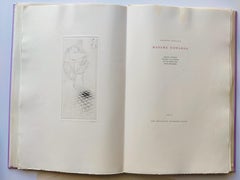Hans Bellmer Madame Edwarda
1960s Prints and Multiples
Engraving
People Also Browsed
1960s Surrealist Figurative Prints
Etching
1970s Surrealist Figurative Prints
Etching
1970s Abstract Abstract Prints
Engraving
Hans Bellmer for sale on 1stDibs
Surrealist German artist Hans Bellmer produced images of contorted, disfigured or bound forms of usually pubescent women in drawings, paintings, photographs and sculptures. He is best known for creating life-sized dolls and disassembled mannequins and used his art to explore themes of sexuality, lust and death as well as to express his viewpoints on politics and society, work through his own traumas and comment on Freudian psychoanalytic principles.
Bellmer was born in Katowice, Germany. He and his brother lived in constant fear of their stern father who showed the boys little affection. Childish play was forbidden by his cold father. Even though he passed university entrance exams, his father insisted that he work in factories and coal mines instead of furthering his education. His father did eventually agree to allow Bellmer to enter the engineering program at the Berlin Polytechnic but his true passion was art.
In 1924, Bellmer quit school and became an illustrator and advertising designer for a left-wing publishing house. Upon discovering Dadaism, he associated with artists such as John Heartfield and George Grosz and attended lectures at the Bauhaus art school. As fascist politics took hold around him — Bellmer was living in Berlin when Hitler came to power, and his own father became a Nazi — he was compelled to create art that reflected his anger and inner turmoil.
Capitalizing on the manifesto of Surrealist André Breton that called for words to be cut up and rearranged, he created a series of mannequins, dressed as children’s dolls, that explored his own erotic obsessions and abusive relationships around him. With like-minded German artist Unica Zürn, Bellmer collaborated on related works that examined bondage and eroticism for 15 years.
Many of Bellmer’s works can be found in public collections around the world, including the Museum of Modern Art in San Francisco, the International Center of Photography in New York and the British Museum in London.
On 1stDibs, find authentic Hans Bellmer prints and other art on 1stDibs.
Finding the Right Prints-works-on-paper for You
Decorating with fine art prints — whether they’re figurative prints, abstract prints or another variety — has always been a practical way of bringing a space to life as well as bringing works by an artist you love into your home.
Pursued in the 1960s and ’70s, largely by Pop artists drawn to its associations with mass production, advertising, packaging and seriality, as well as those challenging the primacy of the Abstract Expressionist brushstroke, printmaking was embraced in the 1980s by painters and conceptual artists ranging from David Salle and Elizabeth Murray to Adrian Piper and Sherrie Levine.
Printmaking is the transfer of an image from one surface to another. An artist takes a material like stone, metal, wood or wax, carves, incises, draws or otherwise marks it with an image, inks or paints it and then transfers the image to a piece of paper or other material.
Fine art prints are frequently confused with their more commercial counterparts. After all, our closest connection to the printed image is through mass-produced newspapers, magazines and books, and many people don’t realize that even though prints are editions, they start with an original image created by an artist with the intent of reproducing it in a small batch. Fine art prints are created in strictly limited editions — 20 or 30 or maybe 50 — and are always based on an image created specifically to be made into an edition.
Many people think of revered Dutch artist Rembrandt as a painter but may not know that he was a printmaker as well. His prints have been preserved in time along with the work of other celebrated printmakers such as Pablo Picasso, Salvador Dalí and Andy Warhol. These fine art prints are still highly sought after by collectors.
“It’s another tool in the artist’s toolbox, just like painting or sculpture or anything else that an artist uses in the service of mark making or expressing him- or herself,” says International Fine Print Dealers Association (IFPDA) vice president Betsy Senior, of New York’s Betsy Senior Fine Art, Inc.
Because artist’s editions tend to be more affordable and available than his or her unique works, they’re more accessible and can be a great opportunity to bring a variety of colors, textures and shapes into a space.
For tight corners, select small fine art prints as opposed to the oversized bold piece you’ll hang as a focal point in the dining area. But be careful not to choose something that is too big for your space. And feel free to lean into it if need be — not every work needs picture-hanging hooks. Leaning a larger fine art print against the wall behind a bookcase can add a stylish installation-type dynamic to your living room. (Read more about how to arrange wall art here.)
Find fine art prints for sale on 1stDibs today.
